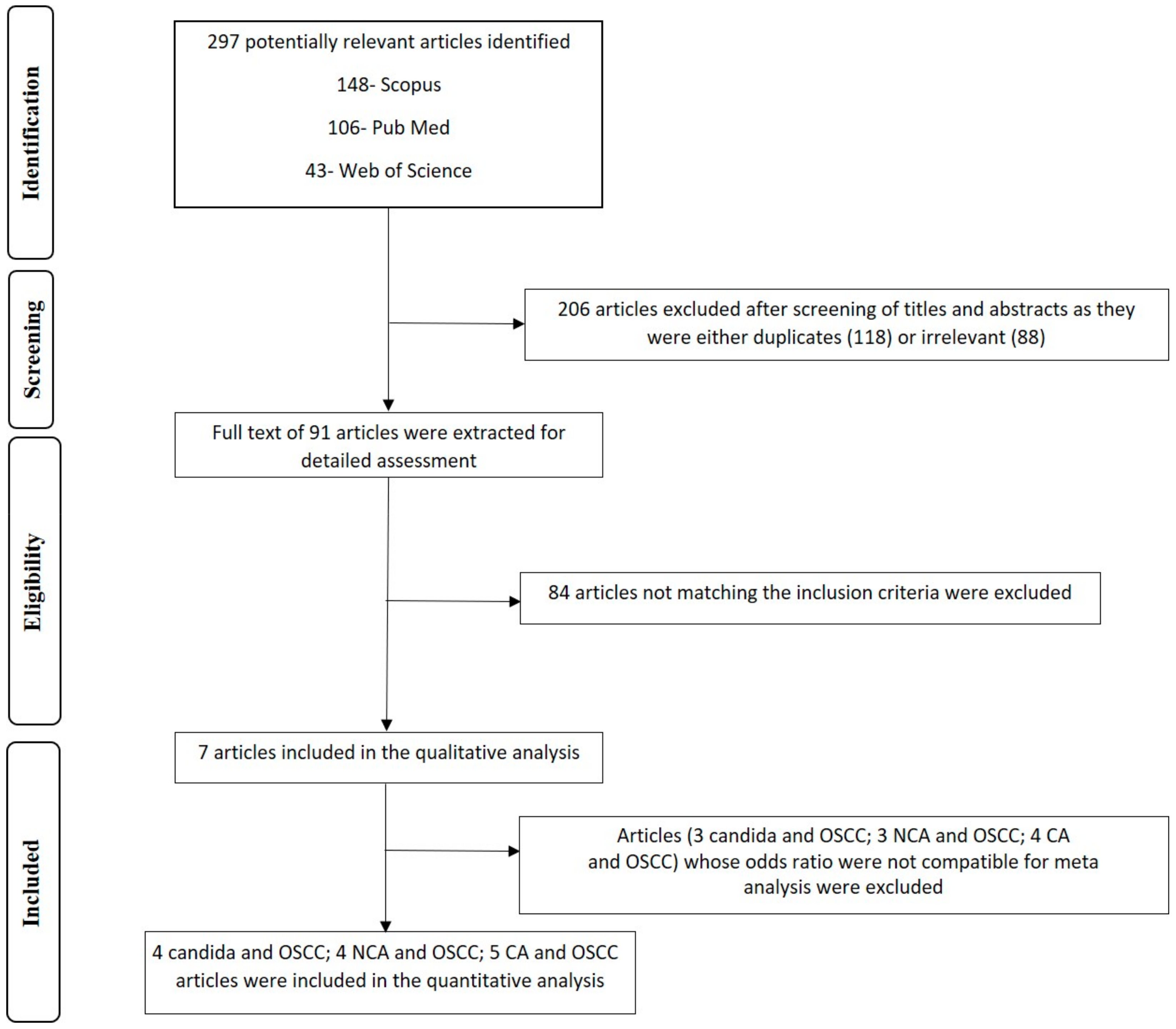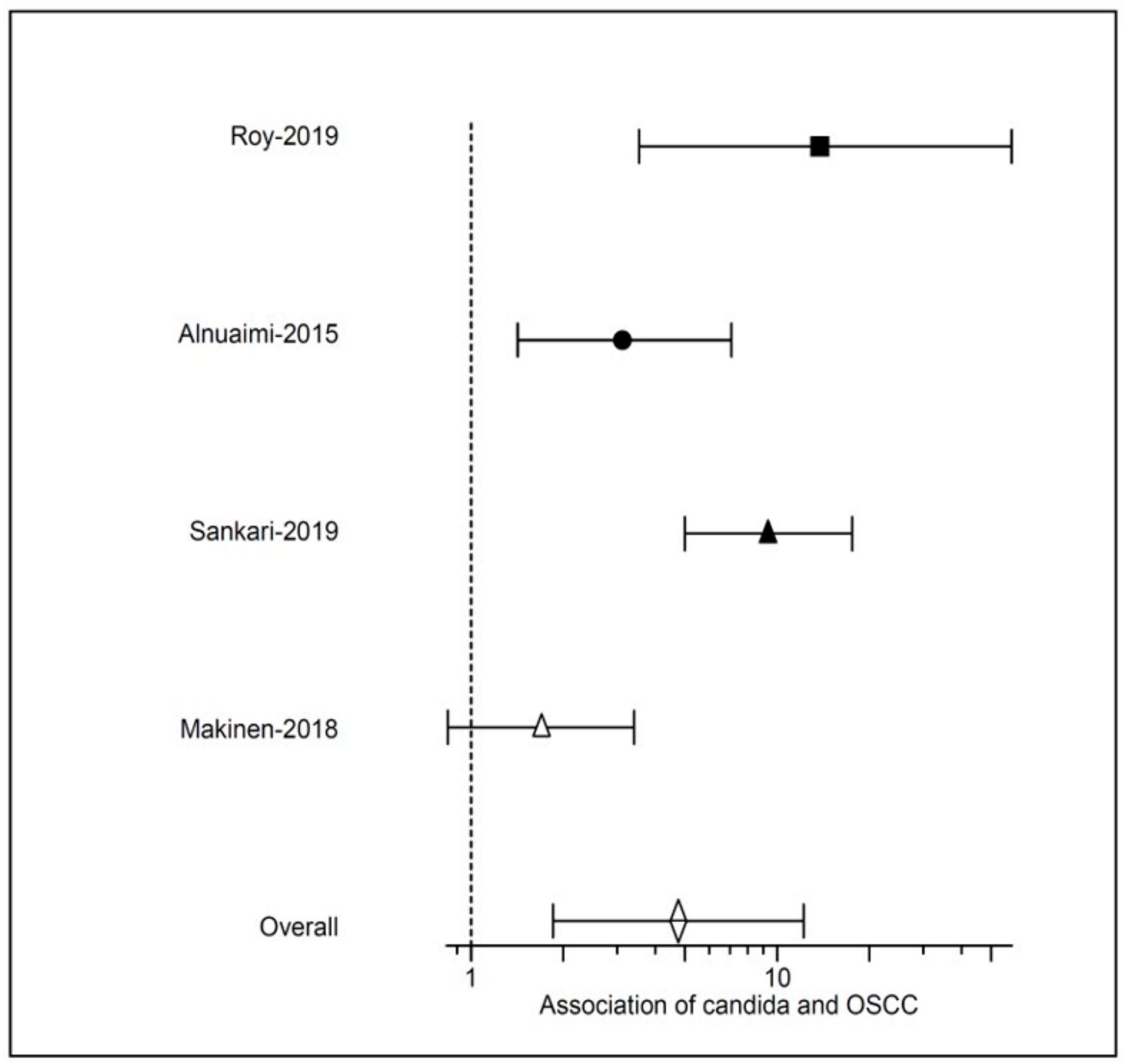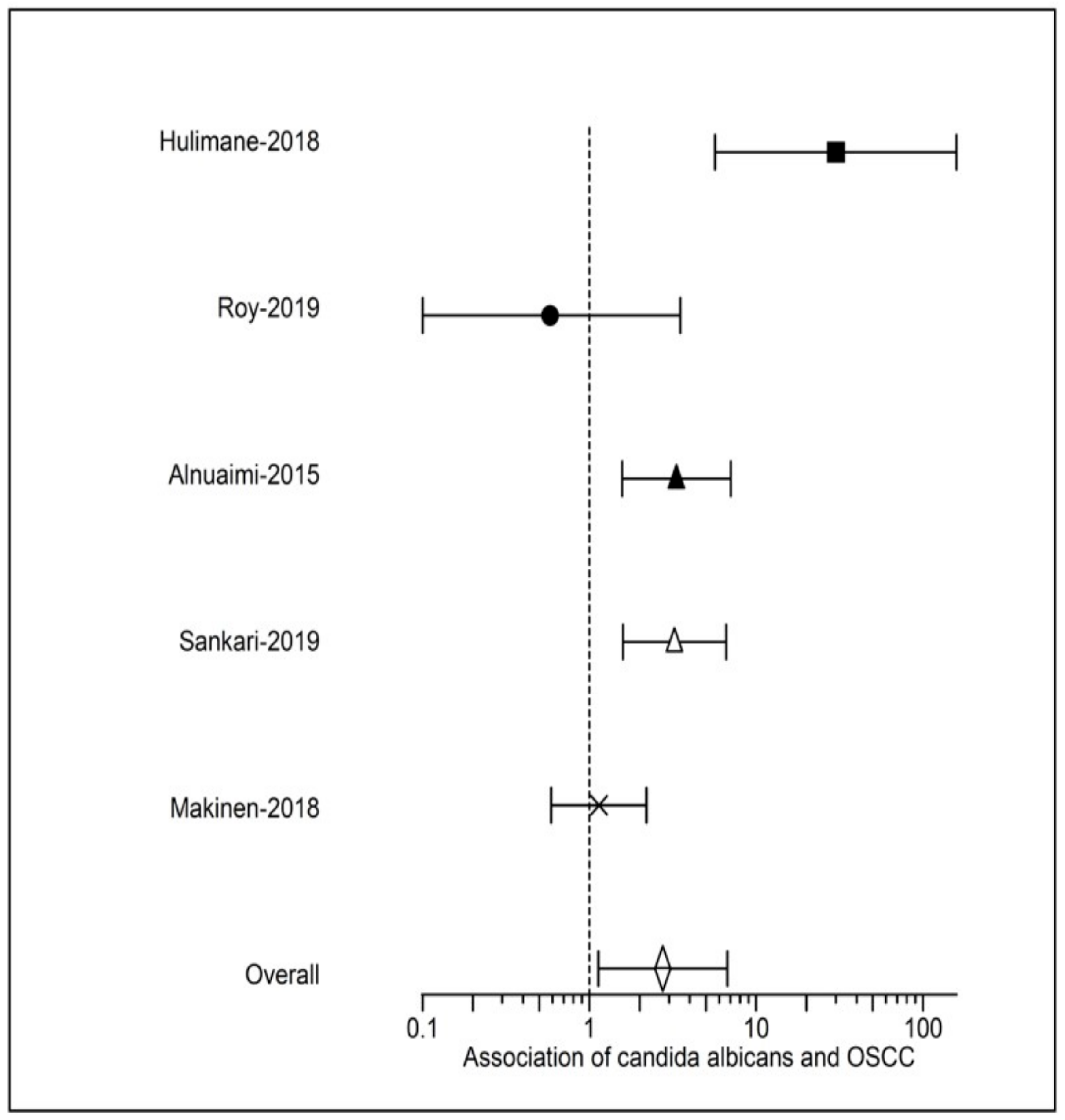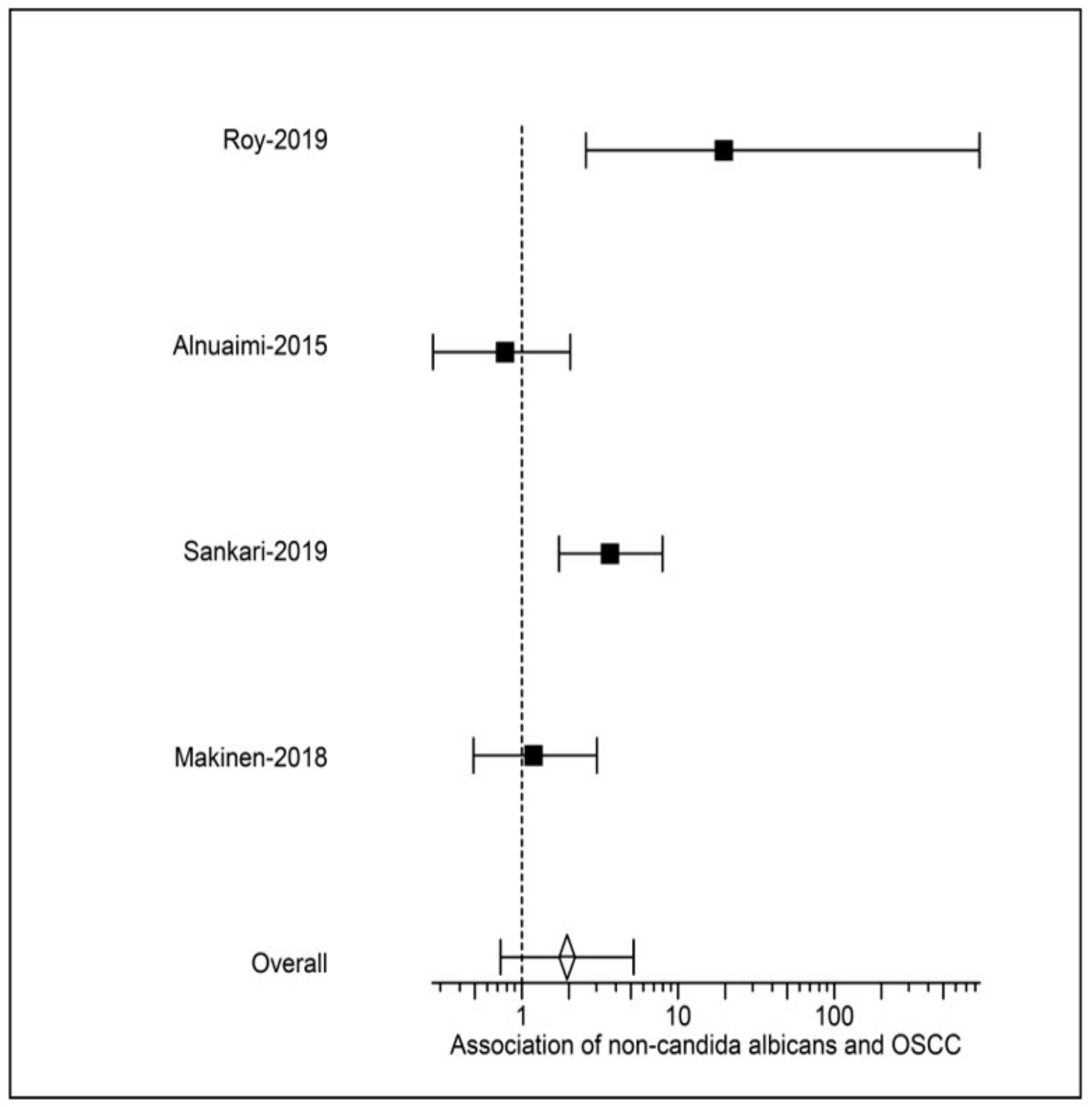Analyzing the Association between Candida Prevalence, Species Specificity, and Oral Squamous Cell Carcinoma: A Systematic Review and Meta-Analysis— Candida and OSCC
Abstract
:1. Introduction
2. Materials and Methods
2.1. Inclusion Criteria
2.2. Exclusion Criteria
2.3. Focused Question
2.4. Search Strategy
2.5. Studies Selection and Data Extraction
2.6. Risk of Biased Assessment
2.7. Statistical Analysis
3. Results
3.1. Study Selection
3.2. Study Characteristics
3.3. Newcastle–Ottawa Scale
3.4. Candida Prevalence in OSCC Compared to the NOM
3.5. Candida Species Specificity in OSCC Compared to the NOM
4. Discussion
5. Conclusions
Funding
Conflicts of Interest
References
- International Agency for Research on Cancer (IARC). IARC Monographs on the Evaluation of Carcinogenic Risk in Humans. Tobacco Smoke and Involuntary Smoking; IARC Press: Lyon, France, 2004; Volume 83. [Google Scholar]
- Gandini, S.; Botteri, E.; Iodice, S.; Boniol, M.; Lowenfels, A.B.; Maisonneuve, P.; Boyle, P. Tobacco smoking and cancer: A meta-analysis. Int. J. Cancer 2008, 122, 155–164. [Google Scholar] [CrossRef] [PubMed]
- Znaor, A.; Brennan, P.; Gajalakshmi, V.; Mathew, A.; Shanta, V.; Varghese, C.; Boffetta, P. Independent and combined effects of tobacco smoking, chewing and alcohol drinking on the risk of oral, pharyngeal and esophageal cancers in Indian men. Int. J. Cancer 2003, 105, 681–686. [Google Scholar] [CrossRef] [PubMed]
- International Agency for Research on Cancer (IARC). Section 2.2. Cancer of the oral cavity and pharynx. In Alcohol Consumption and Ethylcarbamate; IARC Working Group on the Evaluation of Carcinogenic Risks to Humans, Ed.; IARC Press: Lyon, France, 2010; Volume 96, pp. 237–329. [Google Scholar]
- Patil, S.; Arakeri, G.; Alamir, A.W.H.; Patil, S.; Awan, K.H.; Baeshen, H.; Raj, A.T.; Fonseca, F.P.; Brennan, P.A. Is Toombak a risk factor for oral leukoplakia and oral squamous cell carcinoma? A systematic review. J. Oral Pathol. Med. 2019. [Google Scholar] [CrossRef] [PubMed]
- Raj, A.T.; Patil, S.; Gupta, A.A.; Rajkumar, C.; Awan, K.H. Reviewing the role of human papillomavirus in oral cancer using the Bradford Hill criteria of causation. Dis. Mon. 2019, 65, 155–163. [Google Scholar] [CrossRef]
- Kerr, A.R. The oral microbiome and cancer. Am. Dent. Hyg. Assoc. 2015, 89 (Suppl. S1), 20–23. [Google Scholar]
- Schwabe, R.F.; Jobin, C. The microbiome and cancer. Nat. Rev. Cancer 2013, 13, 800. [Google Scholar] [CrossRef] [Green Version]
- Schmidt, B.L.; Kuczynski, J.; Bhattacharya, A.; Huey, B.; Corby, P.M.; Queiroz, E.L.; Nightingale, K.; Kerr, A.R.; De Lacure, M.D.; Veeramachaneni, R.; et al. Changes in abundance of oral microbiota associated with oral cancer. PLoS ONE 2014, 9, e98741. [Google Scholar] [CrossRef]
- Pushalkar, S.; Ji, X.; Li, Y.; Estilo, C.; Yegnanarayana, R.; Singh, B.; Li, X.; Saxena, D. Comparison of oral microbiota in tumor and non-tumor tissues of patients with oral squamous cell carcinoma. BMC Microbiol. 2012, 12, 144. [Google Scholar] [CrossRef] [Green Version]
- Nagy, K.N.; Sonkodi, I.; Szoke, I.; Nagy, E.; Newman, H.N. The microflora associated with human oral carcinomas. Oral Oncol. 1998, 34, 304–308. [Google Scholar] [CrossRef]
- Meurman, J.H.; Uittamo, J. Oral micro-organisms in the etiology of cancer. Acta Odontol. Scand. 2008, 66, 321–326. [Google Scholar] [CrossRef]
- Wang, L.; Ganly, I. The oral microbiome and oral cancer. Clin. Lab. Med. 2014, 34, 711–719. [Google Scholar] [CrossRef] [PubMed]
- García-Castillo, V.; Sanhueza, E.; McNerney, E.; Onate, S.A.; García, A. Microbiota dysbiosis: A new piece in the understanding of the carcinogenesis puzzle. J. Med. Microbiol. 2016, 65, 1347–1362. [Google Scholar] [CrossRef] [PubMed] [Green Version]
- Zhang, Z.; Yang, J.; Feng, Q.; Chen, B.; Li, M.; Liang, C.; Li, M.; Li, Z.; Xu, Q.; Zhang, L.; et al. Compositional and Functional Analysis of the Microbiome in Tissue and Saliva of Oral Squamous Cell Carcinoma. Front. Microbiol. 2019, 10, 1439. [Google Scholar] [CrossRef] [PubMed]
- Rodriguez-Archilla, A.; Alcaide-Salamanca, M.J. Candida species detection in potentially malignant and malignant disorders of the oral mucosa: A meta-analysis. J. Dent. Res. Rev. 2018, 5, 35–41. [Google Scholar] [CrossRef]
- Tamgadge, S.; Tamgadge, A.; Pillai, A.; Chande, M.; Acharya, S.; Kamat, N. Association of Candida sp. with the Degrees of Dysplasia and Oral Cancer: A Study by Calcofluor White under Fluorescent Microscopy. Iran. J. Pathol. 2017, 12, 348–355. [Google Scholar]
- Raj, A.T.; Patil, S.; Awan, K.H. Assessing the carcinogenic potential of non-Candida albicans in cancer therapy-induced oral mucositis. World J. Dent. 2018, 9, 79. [Google Scholar]
- Raj, A.T.; Patil, S.; Sujatha, G.; Seetharam, C.; Kader, N.A. Clinical significance of the floral shift in candidiasis. J. Contemp. Dent. Pract. 2018, 19, 1161–1162. [Google Scholar]
- Gupta, A.A.; Kheur, S.; Raj, A.T.; Mahajan, P. Association of Helicobacter pylori with oral potentially malignant disorders and oral squamous cell carcinoma—A systematic review and meta-analysis. Clin. Oral Investig. 2019, 24, 13–23. [Google Scholar] [CrossRef]
- Raj, A.T.; Patil, S.; Sarode, S.; Sarode, G.; Chandini, R. Evaluating the association between household air pollution and oral cancer. Oral Oncol. 2017, 75, 178–179. [Google Scholar] [CrossRef]
- Josyula, S.; Lin, J.; Xue, X.; Rothman, N.; Lan, Q.; Rohan, T.E.; Hosgood, H.D. Household air pollution and cancers other than lung: A meta-analysis. Environ. Health 2015, 14, 24. [Google Scholar] [CrossRef] [Green Version]
- Loomis, D.; Grosse, Y.; Lauby-Secretan, B.; El Ghissassi, F.; Bouvard, V.; Benbrahim-Tallaa, L.; Guha, N.; Baan, R.; Mattock, H.; Straif, K. The carcinogenicity of outdoor air pollution. Lancet Oncol. 2013, 14, 1262–1263. [Google Scholar] [CrossRef]
- Yuan, T.H.; Lian, I.B.; Tsai, K.Y.; Chang, T.K.; Chiang, C.T.; Su, C.C.; Hwang, Y.H. Possible association between nickel and chromium and oral cancer: A case-control study in central Taiwan. Sci. Total Environ. 2011, 409, 1046–1052. [Google Scholar] [CrossRef] [PubMed]
- Tsai, K.Y.; Su, C.C.; Chiang, C.T.; Tseng, Y.T.; Lian, I.B. Environmental heavy metal as a potential risk factor for the progression of oral potentially malignant disorders in central Taiwan. Cancer Epidemiol. 2017, 47, 118–124. [Google Scholar] [CrossRef]
- Kawakita, D.; Lee, Y.A.; Turati, F.; Parpinel, M.; Decarli, A.; Serraino, D.; Matsuo, K.; Olshan, A.F.; Zevallos, J.P.; Winn, D.M.; et al. Dietary fiber intake and head and neck cancer risk: A pooled analysis in the International Head and Neck Cancer Epidemiology consortium. Int. J. Cancer 2017, 141, 1811–1821. [Google Scholar] [CrossRef] [PubMed]
- Eural, M.; Katsura, F.; Olso, M.; Obata, A.; Nakano, K.; Masuyama, K.; Ishikawa, T. Frequency of HLA-A alleles in Japanese patients with head and neck cancer. Jpn. J. Clin. Oncol. 1999, 29, 535–540. [Google Scholar] [CrossRef] [Green Version]
- Dutta, A.; Saikia, N.; Phooka, J.; Baruah, M.N.; Baruah, S. Association of killer cell immunoglobulin-like receptor gene 2DL1and its HLA-C2 ligand with family history of cancer in oral squamous cell carcinoma. Immunogenetics 2014, 66, 439–448. [Google Scholar] [CrossRef]
- Tsai, S.C.; Sheen, M.C.; Chen, B.H. Association between HLA-DQA1, HLA-DQB1 and oral cancer. Kaohsiung J. Med. Sci. 2011, 27, 441e445. [Google Scholar] [CrossRef] [Green Version]
- Berman, T.A.; Schiller, J.T. Human papillomavirus in cervical cancer and oropharyngeal cancer: One cause, two diseases. Cancer 2017, 123, 2219–2229. [Google Scholar] [CrossRef]
- LeConte, B.A.; Szaniszlo, P.; Fennewald, S.M.; Lou, D.I.; Qiu, S.; Chen, N.W.; Lee, J.H.; Resto, V.A. Differences in the viral genome between HPV-positive cervical and oropharyngeal cancer. PLoS ONE 2018, 13, e0203403. [Google Scholar] [CrossRef] [Green Version]
- Rietbergen, M.M.; van Bokhoven, A.A.J.D.; Lissenberg-Witte, B.I.; Heideman, D.A.M.; Leemans, C.R.; Brakenhoff, R.H.; Bloemena, E. Epidemiologic associations of HPV-positive oropharyngeal cancer and (pre)cancerous cervical lesions. Int. J. Cancer 2018, 143, 283–288. [Google Scholar] [CrossRef]
- Meng, X.; Wang, Q.; He, C.; Chen, M.; Liu, J.; Liu, W.; Yuan, Y. An inverse association of Helicobacter pylori infection with oral squamous cell carcinoma. J. Oral Pathol. Med. 2016, 45, 17–22. [Google Scholar] [CrossRef] [PubMed]
- Hulimane, S.; Maluvadi-Krishnappa, R.; Mulki, S.; Rai, H.; Dayakar, A.; Kabbinahalli, M. Speciation of Candida using CHROMagar in cases with oral epithelial dysplasia and squamous cell carcinoma. J. Clin. Exp. Dent. 2018, 10, e657–660. [Google Scholar] [CrossRef] [PubMed]
- Roy, S.K.; Astekar, M.; Sapra, G.; Chitlangia, R.K.; Raj, N. Evaluation of candidal species among individuals with oral potentially malignant disorders and oral squamous cell carcinoma. J. Oral Maxillofac. Pathol. 2019, 23, 302. [Google Scholar]
- Alnuaimi, A.D.; Wiesenfeld, D.; O’Brien-Simpson, N.M.; Reynolds, E.C.; McCullough, M.J. Oral Candida colonization in oral cancer patients and its relationship with traditional risk factors of oral cancer: A matched case-control study. Oral Oncol. 2015, 51, 139–145. [Google Scholar] [CrossRef]
- Sankari, S.L.; Mahalakshmi, K. Oral candidal carriage among patients with oral squamous cell carcinoma: A case-control study. J. Orofac. Sci. 2019, 11, 55–58. [Google Scholar]
- Castillo, G.V.; de Blanc, S.L.; Sotomayor, C.E.; Azcurra, A.I. Study of virulence factor of Candida species in oral lesions and its association with potentially malignant and malignant lesions. Arch. Oral Biol. 2018, 91, 35–41. [Google Scholar] [CrossRef]
- Gupta, V.; Abhisheik, K.; Balasundari, S.; Devendra, N.K.; Shadab, K.; Anupama, M. Identification of Candida albicans using different culture media and its association in leukoplakia and oral squamous cell carcinoma. J. Oral Maxillofac. Pathol. 2019, 23, 28–35. [Google Scholar]
- Makinen, A.; Nawaz, A.; MAkitie, A.; Meurman, J.H. Role of non-albicans Candida and Candida albicans in oral squamous cell cancer Patients. J. Oral Maxillofac. Surg. 2018, 76, 2564–2571. [Google Scholar] [CrossRef] [Green Version]
- Ramirez-Garcia, A.; Rementeria, A.; Aguirre-Urizar, J.M.; Moragues, M.D.; Antoran, A.; Pellon, A.; Abad-Diaz-de-Cerio, A.; Hernando, F.L. Candida albicans and cancer: Can this yeast induce cancer development or progression? Crit. Rev. Microbiol. 2016, 42, 181–193. [Google Scholar]
- Mohd Bakri, M.; Mohd Hussaini, H.; Rachel Holmes, A.; David Cannon, R.; Mary Rich, A. Revisiting the association between candidal infection and carcinoma, particularly oral squamous cell carcinoma. J. Oral Microbiol. 2010, 2, 5780. [Google Scholar] [CrossRef]
- Nieminen, M.T.; Uittamo, J.; Salaspuro, M.; Rautemaa, R. Acetaldehyde production from ethanol and glucose by non-Candida albicans yeasts in vitro. Oral Oncol. 2009, 45, E245–E248. [Google Scholar] [CrossRef] [PubMed]
- Uittamo, J.; Siikala, E.; Kaihovaara, P.; Salaspuro, M.; Rautemaa, R. Chronic candidosis and oral cancer in APECED-patients: Production of carcinogenic acetaldehyde from glucose and ethanol by Candida albicans. Int. J. Cancer 2009, 124, 754–756. [Google Scholar] [CrossRef] [PubMed]
- Poschl, G.; Seitz, H.K. Alcohol and cancer. Alcohol Alcohol. 2004, 39, 155–165. [Google Scholar] [CrossRef] [Green Version]
- Seitz, H.K.; Stickel, F. Molecular mechanisms of alcohol-mediated carcinogenesis. Nat. Rev. Cancer 2007, 7, 599–612. [Google Scholar] [CrossRef] [PubMed]
- IARC Working Group on the Evaluation of Carcinogenic Risks to Humans. Re-evaluation of some organic chemicals, hydrazine and hydrogen peroxide. In IARC Monographs on the Evaluation of the Carcinogenic Risk of Chemicals to Humans; World Health Organization International Agency for Research on Cancer, Ed.; IARC: Lyon, France, 1999; Volume 77, pp. 319–335. [Google Scholar]
- Manzo-Avalos, S.; Saavedra-Molina, A. Cellular and mitochondrial effects of alcohol consumption. Int. J. Environ. Res. Public Health 2010, 7, 4281–4304. [Google Scholar] [CrossRef] [Green Version]
- Seitz, H.K.; Homann, N. The role of acetaldehyde in alcoholassociated cancer of the gastrointestinal tract. Novartis Found. Symp. 2007, 285, 110–119. [Google Scholar]
- Whibley, N.; Gaffen, S.L. Beyond Candida albicans: Mechanisms of immunity to non-albicans Candida species. Cytokine 2015, 76, 42–52. [Google Scholar] [CrossRef] [Green Version]
- McManus, B.A.; Coleman, D.C. Molecular epidemiology, phylogeny and evolution of Candida albicans. Infect. Genet. Evol. 2014, 21, 166–178. [Google Scholar] [CrossRef] [Green Version]
- Katiraee, F.; Teifoori, F.; Soltani, M. Emergence of azole-resistant Candida species in AIDS patients with oropharyngeal candidiasis in Iran. Curr. Med. Mycol. 2015, 1, 11–16. [Google Scholar]
- Kirkpatrick, W.R.; Revankar, S.G.; McAtee, R.K. Detection of Candida dubliniensisin oropharyngeal samples from human immunodeficiency virus-infected patients in North America by primary CHROMagar Candida screening and susceptibility testing of isolates. J. Clin. Microbiol. 1998, 36, 3007–3012. [Google Scholar] [CrossRef] [Green Version]
- Anwar, K.P.; Malik, A.; Subhan, K.H. Profile of candidiasis in HIV infected patients. Iran. J. Microbiol. 2012, 4, 204–209. [Google Scholar]
- Andes, D.R.; Safdar, N.; Baddley, J.W.; Alexander, B.; Brumble, L.; Freifeld, A.; Hadley, S.; Herwaldt, L.; Kauffman, C.; Lyon, G.M.; et al. The epidemiology and outcomes of invasive Candida infections among organ transplant recipients in the United States: Results of the Transplant-Associated Infection Surveillance Network (TRANSNET). Transpl. Infect. Dis. 2016, 18, 921–931. [Google Scholar] [CrossRef] [PubMed] [Green Version]
- Deorukhkar, S.C.; Saini, S.; Mathew, S. Non-albicans Candida Infection: An emerging threat. Interdiscip. Perspect. Infect. Dis. 2014, 2014, 7. [Google Scholar] [CrossRef] [Green Version]
- Silva, S.; Negri, M.; Henriques, M.; Oliveira, R.; Williams, D.W.; Azeredo, J. Candida glabrata, Candida parapsilosis and Candida tropicalis: Biology, epidemiology, pathogenicity and antifungal resistance. FEMS Microbiol. Rev. 2012, 36, 288–305. [Google Scholar] [CrossRef] [PubMed] [Green Version]
- Kuriyama, T.; Williams, D.W.; Lewis, M.A. In vitro secreted aspartyl proteinase activity of Candida albicans isolated from oral diseases and healthy oral cavities. Oral Microbiol. Immunol. 2003, 18, 405–407. [Google Scholar] [CrossRef] [PubMed]
- Williams, D.W.; Bartie, K.L.; Potts, A.J.; Wilson, M.J.; Fardy, M.J.; Lewis, M.A. Strain persistence of invasive Candida albicans in chronic hyperplastic candidosis that underwent malignant change. Gerodontology 2001, 18, 73–78. [Google Scholar] [CrossRef] [PubMed]
- O’Grady, J.F.; Reade, P.C. Candida albicans as a promoter of oral mucosal neoplasia. Carcinogenesis 1992, 13, 783–786. [Google Scholar] [CrossRef]
- Sanketh, D.S.; Patil, S.; Rao, R.S. Estimating the frequency of Candida in oral squamous cell carcinoma using Calcofluor White fluorescent stain. J. Investig. Clin. Dent. 2016, 7, 304–307. [Google Scholar] [CrossRef]
- Terayama, Y.; Matsuura, T.; Ozaki, K. Lack of Correlation between Aberrant p16, RAR-β2, TIMP3, ERCC1, and BRCA1 Protein Expression and Promoter Methylation in Squamous Cell Carcinoma Accompanying Candida albicans-Induced Inflammation. PLoS ONE 2016, 11, e0159090. [Google Scholar] [CrossRef]
- Sanjaya, P.R.; Gokul, S.; Gururaj, P.B.; Raju, R. Candida in oral pre-cancer and oral cancer. Med. Hypotheses 2011, 77, 1125–1128. [Google Scholar] [CrossRef]
- Marttila, E.; Bowyer, P.; Sanglard, D.; Uittamo, J.; Kaihovaara, P.; Salaspuro, M.; Richardson, M.; Rautemaa, R. Fermentative 2-carbon metabolism produces carcinogenic levels of acetaldehyde in Candida albicans. Mol. Oral Microbiol. 2013, 28, 281–291. [Google Scholar] [CrossRef] [PubMed]




| First Authors Name/Year/Country [Reference Number] | Comparison Groups | Comparison Group Matching | Sample Collected | Modalities Used | Results of Candida, CA, and NCA | |||||
|---|---|---|---|---|---|---|---|---|---|---|
| Hulimane/2018/India [34] | OSCC-18 | OED-32 | NOM-50 | Details not provided | Oral swab | SDA, CHROMagar | Candida positive in OSCC-18, OED-32, NOM-2 CA positive in OSCC-10, OED-7, NOM-2 NCA positive in OSCC-8, OED-25, NOM-0 | |||
| Additional information:C. tropicalis present in OSCC-6, OED-14, NOM-0; C. glabrata present in OSCC-2, OED-10, NOM-0. Mixed colonies: CA and C. glabrada present in OSCC-0, OED-2, NOM-0. | ||||||||||
| Roy/2019/India [35] | OSCC-40 | OPMD-30 | NOM-25 | Gender matched. Age was not matched | Oral swab | SDA, CHROMagar | Candida positive in OSCC-31, OPMD-12, NOM-5 CA positive in OSCC-4, OPMD-7, NOM-4 NCA positive in OSCC-18, OPMD-5, NOM-1 | |||
| Additional information:C. krusei present in OSCC-10, OPMD-5, NOM-1; C. glabrata present in OSCC-6, OED-10, NOM-0; C. topicalis present in OSCC-2, OPMD-0, NOM-0. Mixed colonies: C. glabrata and C. krusei present in OSCC- 1, OPMD-0, NOM-0; C. tropicalis and C. krusei present in OSCC-3, OPMD-0, NOM-0; C. tropicalis and C. glabrata present in OSCC-1, OPMD-0, NOM-0; C. albicans and C. tropicalis present in OSCC-3, OPMD-0, NOM-0;C. krusei, C. glabrata with C. albicans present in OSCC-1, OPMD-0, NOM-0. | ||||||||||
| Alnuaimi/2015/Australia [36] | OSCC-52 | NOM-104 | Age, gender, and denture status matched | Oral rinse | CHROMagar, Real-Time PCR | Candida positive in OSCC-39, NOM-51 CA positive in OSCC-31, NOM-32 NCA positive in OSCC-8, NOM-19 | ||||
| Additional information:CA genotype A present in OSCC-27, NOM-15; CA genotype B present in OSCC-4, NOM-16; CA genotype C present in OSCC-0, NOM-1. C. dubliniensis present in OSCC-3, NOM-3; C. glabrata present in OSCC-2, NOM-3; C. guilliermondii present in OSCC-2, NOM-0. C. krusei present in OSCC-1, NOM-0; C. parapsilosis present in OSCC-0, NOM-9; C. tropicalis present in OSCC-0, NOM-3; C. lusitaniae present in OSCC-0, NOM-1. Mixed colonies: C. albicans genotype A and C.glabrata present in two cases; C. albicans genotype A and C. parapsilosis present in two cases; C. albicans genotype B and C. tropicalis present in one case; C. albicans genotype A and C. lusitaniae present in one case; C. dubliniensis and C. parapsilosis present in one case. Overall OSCC-3, NOM—seven cases had mixed colonies. The article did not mention which mixed colonies were present in which comparative group. | ||||||||||
| Sankari/2019/India [37] | OSCC-90 | NOM-170 | Age and gender matched | Saliva | SDA, CHROMagar, germ tube tests, chlamydospore formation on cornmeal agar, sugar assimilation, and fermentation tests | Candida positive in OSCC-63, NOM-34 CA positive in OSCC-26, NOM-19 NCA positive in OSCC-26, NOM-15 Mixed CA and NCA in OSCC-11, NOM-0 | ||||
| Additional information: Mixed colonies (CA and NCA) present in OSCC-11, NOM-0. | ||||||||||
| Castillo/2018/Argentina [38] | OSCC-25 | Atypical OLP-11 | Chronic candidiasis-25 | NOM-15 | Age and gender matched | Oral swab | CHROMagar, colony morphology, sugar fermentation tests, germ tube test, morphology in maize agar, 42 °C growth | Candida positive in OSCC-25, atypical OLP-11, chronic candidiasis-25, NOM-15 CA positive in OSCC-16, atypical OLP-6, chronic candidiasis-11, NOM-15 NCA positive in OSCC-9, atypical OLP-2, chronic candidiasis-7, NOM-0 | ||
| Additional information:C. dubliniensis present in OSCC-2, NOM-0; C. glabrata present in OSCC-1, NOM-0; C. krusei present in OSCC-4, NOM-0; C. tropicalis present in OSCC-1, atypical lichen planus-2, chronic candidiasis-7, NOM-0. Mixed colonies (CA and C.tropicalis) present in OSCC-0, atypical lichen planus-0, chronic candidiasis-2, NOM-0. | ||||||||||
| Gupta/2019/ India [39] | OSCC-30 | OL-30 | NOM-20 | Details not provided | Saliva | SDA, germ tube test, chlamydospore production in milk serum and in cornmeal broth +5% milk media | Candida positive in OSCC-14, OL-11, NOM-0CA positive in OSCC-11, OL-4, NOM-0 NCA positive in OSCC-3, OL-7, NOM-0 | |||
| Additional information: The NCA identified was C. tropicalis. Details on mixed colonies were not provided. | ||||||||||
| Makinen/2018/Finland [40] | OSCC-100 | NOM-75 | Age and gender-matched | Saliva | CHROMagar API ID 32C, and Bichro-Dubli Fumouze latex agglutination tests | Candida positive in OSCC-74, NOM-47 CA positive in OSCC-63, NOM-45 NCA positive in OSCC-17, NOM-11 | ||||
| Additional information:C. dubliniensis present in OSCC-6, NOM-4; C. tropicalis present in OSCC-3, NOM-0; C. glabrata present in OSCC-2, NOM-4; C. parapsilosis present in OSCC-2, NOM-1; Candida sake present in OSCC-2, NOM-0; C. krusei present in OSCC-1, NOM-0; C. guillermondii present in OSCC-1, NOM-1; C. kefyr present in OSCC-0, NOM-1. Mixed colonies (2 species) present in seven cases. Mixed colonies (three species) present in one case. The article did not mention which mixed colonies were present in which comparative group. | ||||||||||
| The First Author [Reference Number] | Selection | Comparability | Exposure | Total Score | |||||||
|---|---|---|---|---|---|---|---|---|---|---|---|
| Case Definition | Case Representativeness | Control Selection | Control Definition | Matching Known Confounding Factor | Matching Potential Confounding Factor | Secure Patient Records | Interviewer Blinded to Cases and Control | The Similarity in the Case and Control Ascertainment | Non-Response Rate | ||
| Hulimane [34] | 1 | 1 | 1 | 1 | 0 | 0 | 1 | 0 | 1 | 0 | 6 |
| Roy [35] | 1 | 1 | 1 | 1 | 0 | 0 | 1 | 0 | 1 | 0 | 6 |
| Alnuaimi [36] | 1 | 1 | 1 | 1 | 1 | 1 | 1 | 0 | 1 | 0 | 7 |
| Sankari [37] | 1 | 1 | 1 | 1 | 1 | 0 | 1 | 0 | 1 | 0 | 7 |
| Castillo [38] | 1 | 1 | 1 | 1 | 1 | 0 | 1 | 0 | 1 | 0 | 7 |
| Gupta [39] | 1 | 1 | 1 | 1 | 0 | 0 | 1 | 0 | 1 | 0 | 6 |
| Makinen [40] | 1 | 1 | 1 | 1 | 1 | 0 | 1 | 0 | 1 | 0 | 7 |
| Author/Year/Country [Reference Number] | Odds Ratio | 95% Confidence Interval |
|---|---|---|
| Candida and OSCC | ||
| Roy/2019/India [35] | 13.78 | 3.54–58.27 |
| Alnuaimi/2015/Australia [36] | 3.12 | 1.42–7.09 |
| Sankari/2019/India [37] | 9.33 | 4.99–17.54 |
| Makinen/2015/Finland [40] | 1.70 | 0.84–3.41 |
| CA and OSCC | ||
| Hulimane/2018/India [34] | 30.00 | 5.67–158.80 |
| Roy/2019/India [35] | 0.58 | 0.10–3.51 |
| Alnuaimi/2015/Australia [36] | 3.32 | 1.57–7.05 |
| Sankari/2019/India [37] | 3.23 | 1.59–6.62 |
| Makinen/2015/Finland [40] | 1.14 | 0.59–2.20 |
| CA Genotype A | ||
| Alnuaimi/2015/Australia [36] | 6.41 | 2.77–14.96 |
| CA Genotype B | ||
| Alnuaimi/2015/Australia [36] | 0.46 | 0.11–1.54 |
| NCA and OSCC | ||
| Roy/2019/India [35] | 19.64 | 2.57–851.39 |
| Alnuaimi/2015/Australia [36] | 0.78 | 0.27–2.04 |
| Sankari/2019/India [37] | 3.66 | 1.73–7.93 |
| Makinen/2015/Finland [40] | 1.19 | 0.49–3.02 |
| C. dubliniensis and OSCC | ||
| Alnuaimi/2015/Australia [36] | 2.06 | 0.26–15.88 |
| Makinen/2015/Finland [40] | 1.13 | 0.26–5.67 |
| C. glabrata and OSCC | ||
| Alnuaimi/2015/Australia [36] | 1.35 | 0.11–12.13 |
| Makinen/2015/Finland [40] | 0.36 | 0.03–2.62 |
| C. krusei and OSCC | ||
| Roy/2019/India [35] | 8.00 | 0.99–361.35 |
| C. parapsilosis and OSCC | ||
| Makinen/2015/Finland [40] | 1.51 | 0.08–90.28 |
| C. guillermondii and OSCC | ||
| Makinen/2015/Finland [40] | 0.75 | 0.01–59.46 |
| Overall Ratio | 95% Confidence Interval |
|---|---|
| Candida and OSCC | |
| 4.75 | 1.85–12.19 |
| CA and OSCC | |
| 2.75 | 1.13–6.71 |
| NCA and OSCC | |
| 1.95 | 0.73–5.20 |
© 2020 by the author. Licensee MDPI, Basel, Switzerland. This article is an open access article distributed under the terms and conditions of the Creative Commons Attribution (CC BY) license (http://creativecommons.org/licenses/by/4.0/).
Share and Cite
Patil, S. Analyzing the Association between Candida Prevalence, Species Specificity, and Oral Squamous Cell Carcinoma: A Systematic Review and Meta-Analysis— Candida and OSCC. Appl. Sci. 2020, 10, 1099. https://doi.org/10.3390/app10031099
Patil S. Analyzing the Association between Candida Prevalence, Species Specificity, and Oral Squamous Cell Carcinoma: A Systematic Review and Meta-Analysis— Candida and OSCC. Applied Sciences. 2020; 10(3):1099. https://doi.org/10.3390/app10031099
Chicago/Turabian StylePatil, Shankargouda. 2020. "Analyzing the Association between Candida Prevalence, Species Specificity, and Oral Squamous Cell Carcinoma: A Systematic Review and Meta-Analysis— Candida and OSCC" Applied Sciences 10, no. 3: 1099. https://doi.org/10.3390/app10031099
APA StylePatil, S. (2020). Analyzing the Association between Candida Prevalence, Species Specificity, and Oral Squamous Cell Carcinoma: A Systematic Review and Meta-Analysis— Candida and OSCC. Applied Sciences, 10(3), 1099. https://doi.org/10.3390/app10031099





